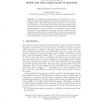Free Online Productivity Tools
i2Speak
i2Symbol
i2OCR
iTex2Img
iWeb2Print
iWeb2Shot
i2Type
iPdf2Split
iPdf2Merge
i2Bopomofo
i2Arabic
i2Style
i2Image
i2PDF
iLatex2Rtf
Sci2ools
FSE
1999
Springer
1999
Springer
On the Security of Double and 2-Key Triple Modes of Operation
The DES has reached the end of its lifetime due to its too short key length and block length (56 and 64 bits respectively). As we are awaiting the new AES, triple (and double) encryption are the common solution. However, several authors have shown that these multiple modes are much less secure than anticipated. The general belief is that these schemes should not be used, as they are not resistant against attacks requiring 264 chosen plaintexts. This paper extends the analysis by considering some more realistic attack models. It also presents an improved attack on multiple modes that contain an OFB mode and discusses practical solutions that take into account realistic constraints.
| Added | 04 Aug 2010 |
| Updated | 04 Aug 2010 |
| Type | Conference |
| Year | 1999 |
| Where | FSE |
| Authors | Helena Handschuh, Bart Preneel |
Comments (0)

